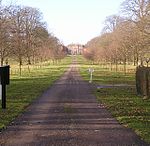Goodrich, Herefordshire
Villages in Herefordshire

Goodrich is a village in south Herefordshire, England close to Gloucestershire and the Forest of Dean, situated near the River Wye at grid reference SO574193. It is known for its Norman and mediaeval castle built with Old Red Sandstone. The village of Goodrich grew up next to Goodrich Castle, a 'Marcher Castle' dating to c. 1101 which stands on a high spur of land commanding a strategic position above Kerne Bridge, an ancient crossing point of the Wye. The population of the Civil Parish at the 2011 census was 550.
Excerpt from the Wikipedia article Goodrich, Herefordshire (License: CC BY-SA 3.0, Authors, Images).Goodrich, Herefordshire
Geographical coordinates (GPS) Address Nearby Places Show on map
Geographical coordinates (GPS)
| Latitude | Longitude |
|---|---|
| N 51.871 ° | E -2.619 ° |
Address
HR9 6HU
England, United Kingdom
Open on Google Maps







